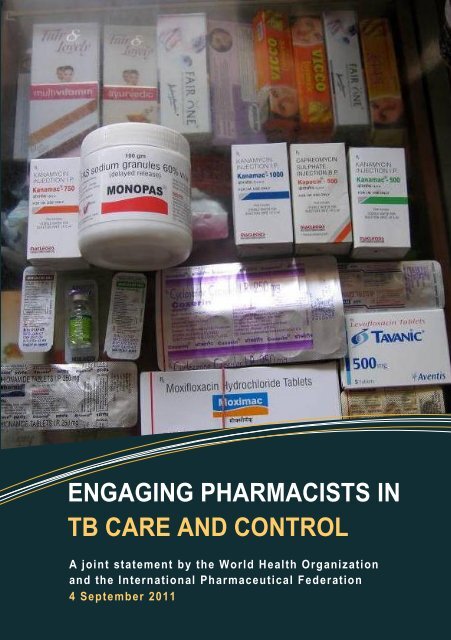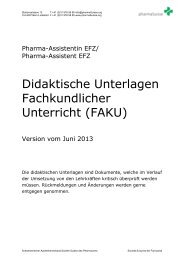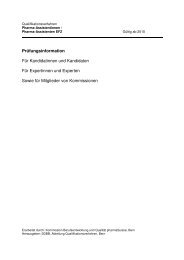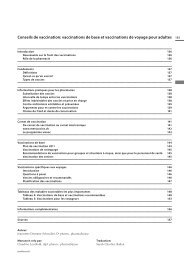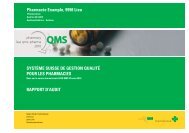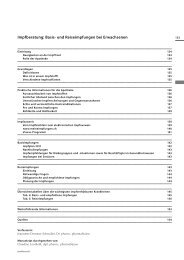ENGAGING PHARMACISTS IN TB CARE AND CONTROL - FIP
ENGAGING PHARMACISTS IN TB CARE AND CONTROL - FIP
ENGAGING PHARMACISTS IN TB CARE AND CONTROL - FIP
Create successful ePaper yourself
Turn your PDF publications into a flip-book with our unique Google optimized e-Paper software.
<strong>ENGAG<strong>IN</strong>G</strong> <strong>PHARMACISTS</strong> <strong>IN</strong><br />
<strong>TB</strong> <strong>CARE</strong> <strong>AND</strong> <strong>CONTROL</strong><br />
A joint statement by the World Health Organization<br />
and the International Pharmaceutical Federation<br />
4 September 2011
DISCLAIMER<br />
The designations employed and the presentation of the material in this publication do not imply the expression of any<br />
opinion whatsoever on the part of the World Health Organization concerning the legal status of any country, territory, city or<br />
area or of its authorities, or concerning the delimitation of its frontiers or boundaries.<br />
The mention or graphic presentation of specific companies or of certain manufacturers’ products does not imply that they are<br />
endorsed or recommended by the World Health Organization in preference to others of a similar nature that are not<br />
mentioned. Errors and omissions excepted, the names of proprietary products are distinguished by initial capital letters.<br />
All reasonable precautions have been taken by the World Health Organization to verify the information contained in this<br />
publication. However, the published material is being distributed without warranty of any kind, either expressed or implied.<br />
The responsibility for the interpretation and use of the material lies with the reader. In no event shall the World Health<br />
Organization be liable for damages arising from its use.<br />
Cover photo credits: Dr Fraser Douglas Wares
Background<br />
Every year, more than 9 million new cases of tuberculosis (<strong>TB</strong>)<br />
occur and nearly 2 million people die of the disease. Nearly half a<br />
million cases have the multidrug-resistant form of the disease.<br />
While Asia bears the largest burden of the disease, sub-Saharan<br />
Africa has the highest incidence of drug-susceptible <strong>TB</strong> and<br />
Eastern Europe has the highest incidence of multidrug-resistant<br />
<strong>TB</strong> (MDR-<strong>TB</strong>).<br />
Considerable progress has been<br />
made over the past decade:<br />
between 1995 and 2009, proper <strong>TB</strong><br />
care and control averted up to 6<br />
million deaths and cured 41 million<br />
people.<br />
A great deal of concerted effort is still<br />
required if the <strong>TB</strong>-related Millennium<br />
Development Goals are<br />
to be met by 2015 and the Stop <strong>TB</strong><br />
Partnership's vision of a world free of<br />
<strong>TB</strong> is to be realized by 2050.<br />
In several countries, national <strong>TB</strong><br />
programmes have made significant<br />
progress in involving diverse public,<br />
private, voluntary and corporate<br />
health-care providers in <strong>TB</strong> care and<br />
control. Pharmacists constitute an<br />
important and essential part of the<br />
health work-force. In many countries,<br />
pharmacists are the frontline healthcare<br />
providers and often a first point of<br />
contact for people with symptoms of<br />
<strong>TB</strong>. Systematic efforts to involve<br />
pharmacists in <strong>TB</strong> care and control<br />
therefore need to be undertaken as a<br />
part of strengthening health systems<br />
in general and health work-force in<br />
particular.
Working together:<br />
WHO and <strong>FIP</strong><br />
The World Health Organization (WHO) and the<br />
International Pharmaceutical Federation (<strong>FIP</strong>) intend to<br />
intensify their collaboration towards care and control of<br />
<strong>TB</strong> and MDR-<strong>TB</strong> globally.<br />
While recognizing the broader role of<br />
pharmacists in the development and<br />
use of anti-<strong>TB</strong> medicines, this joint<br />
statement focuses on the role of<br />
pharmacists directly involved in<br />
delivering care for people with <strong>TB</strong>.<br />
This statement builds on WHO’s<br />
mandate in public health and <strong>FIP</strong>’s<br />
previous collaboration with WHO on<br />
important public health issues<br />
including the role of the pharmacists in<br />
the fight against the HIV-AIDS<br />
pandemic, good pharmacy practice,<br />
prevention of anti-microbial<br />
resistance, and encouraging<br />
adherence to long-term treatments.
Joint action<br />
1. WHO and <strong>FIP</strong> have jointly drawn up the basis for actionoriented<br />
collaboration between national <strong>TB</strong> programmes and<br />
national pharmacy associations in the fight against <strong>TB</strong> and<br />
MDR-<strong>TB</strong>.<br />
2. WHO undertakes to promote the need for these collaborative<br />
actions to WHO Member States, their national <strong>TB</strong><br />
programmes and drug regulatory authorities as well as to<br />
Stop <strong>TB</strong> partners worldwide.<br />
3. <strong>FIP</strong> undertakes to promote these actions to national<br />
pharmacy associations worldwide and, through them, to<br />
individual pharmacists and to the health authorities of<br />
respective countries.<br />
4. Both WHO and <strong>FIP</strong> will use this joint statement to harness<br />
the contribution of pharmacists in delivering health services<br />
as part of strengthening health systems.<br />
Dr Hiroki Nakatani<br />
Assistant Director-General,<br />
World Health Organization<br />
Dr Michel Buchmann<br />
President<br />
International Pharmaceutical<br />
Federation
Collaborative actions<br />
WHO and <strong>FIP</strong> urge national <strong>TB</strong> programmes and national<br />
pharmacy associations, to develop and implement plans for<br />
engaging pharmacists in the fight against <strong>TB</strong> within the<br />
context of national health systems and services. These plans<br />
should take into consideration the following actions that<br />
would enable national <strong>TB</strong> programmes and national pharmacy<br />
associations to work together to:<br />
1. Provide joint stewardship in developing<br />
policy guidance and resource<br />
mobilization to engage pharmacists in<br />
<strong>TB</strong> care and control. For this purpose,<br />
to undertake as a first step, situation<br />
assessments to understand the current<br />
role and potential contribution of<br />
pharmacists in health service delivery<br />
in general, and <strong>TB</strong> care and control in<br />
particular. The process should also<br />
entail consultation and collaboration<br />
with relevant stakeholders to identify<br />
educational, managerial and regulatory<br />
approaches to system-atically engage<br />
pharmacists in <strong>TB</strong> care and control.<br />
2. Undertake orientation and training of<br />
pharmacists to enable their effective<br />
contribution to <strong>TB</strong> care and control,<br />
taking into account the local context.<br />
To this effect, the training curricula<br />
of pharmacy students may require<br />
updating to incorporate current<br />
knowledge and practices in <strong>TB</strong><br />
care and control.<br />
3. Facilitate effective contribution of<br />
pharmacists to specific areas<br />
related to <strong>TB</strong> care and control<br />
including increasing awareness of<br />
<strong>TB</strong> among lay people and patients<br />
about health facilities linked to<br />
national <strong>TB</strong> programmes providing<br />
quality-assured diagnosis
and treatment of <strong>TB</strong>; referring people<br />
with symptoms of <strong>TB</strong> to appropriate<br />
health-care facilities for early diagnosis;<br />
providing supportive supervision of <strong>TB</strong><br />
patients including directly -observed<br />
treatment to promote adherence and<br />
prevent multidrug resistance; and<br />
supporting diverse health-care<br />
providers to ensure that national<br />
guidelines based on International<br />
Standards for Tuberculosis Care are<br />
followed.<br />
4. Promote rational use of anti-<strong>TB</strong><br />
medicines and ensure that qualityassured<br />
medicines are procured and<br />
supplied and that fixed-dose<br />
combinations recommended by WHO<br />
are used. Furthermore, dispensing anti-<br />
<strong>TB</strong> medicines that have not been<br />
certified as safe and effective and sale<br />
of inappropriate combinations should<br />
be stopped. The sale of anti- <strong>TB</strong><br />
medicines over the counter without a<br />
prescription must also be prohibited.<br />
5. Maintain a continuous dialogue with<br />
health-care providers to rationalize<br />
and strengthen their <strong>TB</strong><br />
management practices. Pharmacy<br />
associations should contribute to<br />
development of national guidelines<br />
on the rational use of anti-<strong>TB</strong><br />
medicines and support adherence to<br />
these guidelines in practice.<br />
6. Engage pharmacists and their<br />
associations to join the Stop <strong>TB</strong><br />
Partnership’s efforts at local, national<br />
and global levels. All relevant<br />
stakeholders, including the<br />
pharmaceutical industry, academic<br />
institutions and civil society<br />
organizations should understand and<br />
support the role of pharmacists in <strong>TB</strong><br />
care and control.<br />
7. Develop and implement a system to<br />
monitor, evaluate and improve<br />
collaboration between national <strong>TB</strong><br />
programmes and national pharmacy<br />
associations. Documentation and<br />
sharing of experiences and lessons<br />
learnt should establish an evidencebase<br />
of the role of pharmacists in <strong>TB</strong><br />
care and control and also help to<br />
identify and scale-up successful best<br />
practice models.


